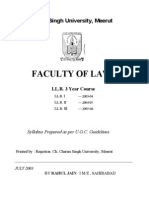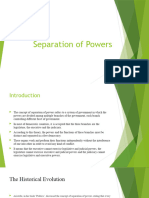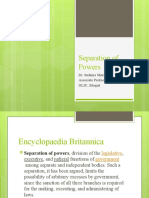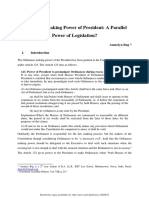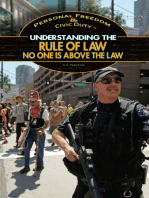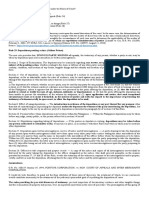Separation of Powers
Separation of Powers
Uploaded by
Banni BanniCopyright:
Available Formats
Separation of Powers
Separation of Powers
Uploaded by
Banni BanniCopyright
Available Formats
Share this document
Did you find this document useful?
Is this content inappropriate?
Copyright:
Available Formats
Separation of Powers
Separation of Powers
Uploaded by
Banni BanniCopyright:
Available Formats
86
1. SEPARATION OF POWERS
Introduction:
1. The Constitution recognizes the three-fold functional division of governmental powers: The Legislature,
The Execute and the Judiciary (Montesquieu’s idea).
2. Article 50 expressly requires the State to apply the principle of separation of the judiciary from the
executive as a sound principle of Government.
For essay:
1. Montesquieu who for the first time gave it a systematic and scientific formulation in his book 'Esprit des
Lois (The Spirit of the laws) published in the year 1748.
2. The Executive should not exercise the legislative or judicial powers because this may threaten the freedom
and liberty of individuals.
3. The Legislative should never exercise the executive or judicial powers as this may lead to arbitrariness and
hence, end the liberty.
4. The Judiciary should not exercise the executive or legislative powers because then a judge would behave
like a dictator.
Objectives of SOP:
1. It aims to eliminate arbitrariness, totalitarianism and tyranny and promote an accountable and democratic
form of government.
2. It prevents the misuse of powers within the different organs of the government. The Indian Constitution
provides certain limits and boundaries for each domain of the government and they are supposed to
perform their function within such limits. In India, the Constitution is the ultimate sovereign and if anything
goes beyond the provisions of the constitution, it will automatically be considered as null, void and
unconstitutional.
3. It keeps a check on all the branches of the government by making them accountable for themselves.
4. Separation of powers maintains a balance among the three organs of government by dividing the powers
among them so that powers do not concentrate on any one branch leading to arbitrariness.
5. This principle allows all the branches to specialize themselves in their respective field with an intention to
enhance and improve the efficiency of the government.
Separation of powers- UK Constitution:
1. The United Kingdom practices the unitary parliamentary constitutional monarchy.
2. The concept of separation of powers is applied in the UK but not in its rigid sense because the UK has an
unwritten constitution.
3. The Parliament is the sovereign rule-making body in the UK.
4. The government is answerable to the Parliament. Practically, the executive is controlled by the House of
Commons.
5. The Judiciary, however, is independent of executive control. But the judges of the Supreme Court can be
removed from the address of both houses if found with any charge of corruption.
Separation of powers- US Constitution:
1. The US has a written constitution and governed by the Presidential form of government
2. This concept is well-defined and clear under the American Constitution.
3. The President and his ministers are the executive authority and they are not members of the Congress.
4. The ministers are accountable to the President only and not to Congress.
5. The tenure of the President is fixed and independent of the majority in Congress.
6. Congress is the sovereign legislative authority. It consists of two houses- the Senate and the House of
Representatives.
7. The impeachment of the President can be done by Congress.
e-mail: contact@atishmathur.com www.atishmathur.com telegram: https://t.me/csepaper2atish
87
8. The treaties entered by the President are to be approved by the Senate. The Supreme Court of the USA is
independent.
9. It may declare any action of the executive as well as the legislature as unconstitutional if found so.
10. President interferes in the functioning of Congress by exercising his veto power. He also makes the
appointment of the Judges thus, interfering in judicial powers.
11. Similarly, Congress interferes in the powers of the Courts by passing procedural laws, making special courts
and approving the judges' appointment.
12. The judiciary, by exercising the power of judicial review interferes in the powers of Congress and the
President.
Critical analysis- the Indian perspective- constitutional provisions:
1. The Indian Constitution does not expressly mention the theory of separation of powers. In fact, the
Constituent Assembly Debates indicate that separation of powers in its rigid or literal sense was never
intended to be adopted by the constitution makers at all.
2. This was evident when the insertion of a new Article 40-A, that prescribed a complete separation of
powers between the three branches, to the Constitution was proposed by Prof. K T Shah in the Constituent
Assembly.
3. Dr. B.R Ambedkar, while acknowledging the separation of the executive from the judiciary, emphasized
upon the importance of interdependence between the executive and legislature for the proper
functioning of their complicated duties in the government.
Constitutional provisions supporting SOP:
1. Distinct institutions and core powers:
1. Under Articles 53(1) and 154 of the Constitution, the executive powers of the Union and States
have been expressly vested in the President and the Governor respectively.
2. Article 245 vests the Central and State law making authority to the Parliament and State
Legislatures respectively, empowering the Parliament to make laws for the whole country
3. Article 50 categorically prescribes the separation of the executive from the judiciary under the
Indian governmental structure. Hence, an apparent demarcation between the three branches and
their functions is found to be broadly laid out under the Constitution.
2. Autonomy and independence
1. Articles 122 and 212 of the Constitution avert the Courts from inquiring into the proceedings of the
Parliament and State legislatures respectively.
2. Articles 105 and 194 confer judicial immunity to the MPs and MLAs from anything spoken during
their sessions
3. Article 361, the President and Governor are also not accountable to the Courts for the exercise of
their powers and duties in the office
4. Articles 121 and 211: The Supreme and High Court judges are also immune from the scrutiny of their
conduct in the Parliament or State Legislature.
Provisions leaning against a pure separation of powers:
1. Overlapping personnel
1. The Indian governmental structure is such that there is a commonality of personnel between the
two organs, with the Union Council of Ministers being members of both the Parliament (Article 75)
+ the executive (Article 74).
2. Even the President is regarded as part of the Legislature along with the Houses of Parliament
(Article 79).
2. Overlapping powers (E & L):
1. There is also a commonality of powers between the two organs, with the powers of the executive
prescribed as co-extensive to that of the legislature (Article 74)
e-mail: contact@atishmathur.com www.atishmathur.com telegram: https://t.me/csepaper2atish
88
2. The executive exercises legislative powers when it comes to the President’s authority to issue
ordinances when the Houses of the Parliament are not in session, which is considered equivalent
to a Parliamentary Act (Article 123)
3. The President’s assent is required for the passing of bills proposed by the legislature (Article 111).
The President also exercises legislative functions during the proclamation of State Emergency
(Article 356), where he has the authority to make laws for the state upon the dissolution of the
State Legislature
4. Moreover, the very concept of delegated legislation is based on the conferment of legislative
powers to the executive. This delegation is carried out in the name of administrative adjudication
of the rights of the citizens and is implicitly allowed by the Constitution (Articles 372 and 13)
5. The Council of Ministers is also collectively responsible to the Lok Sabha, indicating another overlap
between the two organs (Article 75).
6. Hence, it has been said that there is a fusion between the executive and the legislative in India, but
without any friction occurring between them.
3. Overlapping powers (E & J):
1. The President is empowered to grant pardon, reprieve, respite or remise to the sentence of any
person convicted by Supreme Court of India, representing a judicial power (Article 72).
2. The President also performs a judicial act in resolving disputes relating to the age of judges of the
courts as regards their retirement from judicial office (Articles 124(2)(a) and 217(3)).
3. On the other hand, the judiciary exercises executive functions under Article 227 of the Constitution
wherein the High Courts have been granted the power of supervision over subordinate courts.
4. Further, they carry out other administrative functions such as the transfer of cases under Article
228.
4. Overlapping powers (L & J):
1. The Parliament also performs judicial functions such as punishing its members or outsiders for
contempt or breach of parliamentary privilege.
2. The judiciary, on the other hand, performs legislative functions in laying down rules and procedures
for court proceedings and practice (Article 145).
Checks & balances:
1. The Parliament has the authority to initiate impeachment proceedings against the President and exercises
a check on his activities (Article 61).
2. The Parliament and President together have the power to remove judges of the Supreme Court (Article
124) and High Courts (Article 217) and the President further possess the power to appoint the judges of
the High Courts and the Supreme Court (Article 124 and 217).
3. Most importantly, the power of judicial review possessed by the Courts under Articles 32, 226 and 136
reflects a paradigm of checks and balances, as it allows the Courts to strike down the laws of the
Parliament or actions of the executive that are adjudged unconstitutional.
Judicial approach towards SOP in India:
1. Ram Jawaya Kapur v. State of Punjab : The Constitution of India has not acknowledged the doctrine of
separation of power emphatically but the functions and powers of all the organs have been adequately
distinguished. India’s constitutional structure sufficiently differentiates the functions and branches of the
Government to prevent the assumption of functions of one organ by another.
2. In the Re Delhi Laws Act case – it was highlighted how the British Parliamentary system adopted by India
entails the responsibility of the executive to the legislature as its essential feature, and does not strictly
follow the doctrine.
3. Indira Nehru Gandhi v. Raj Narain : A rigid sense of separation of powers which has been given under the
American and Australian constitution does not apply to India. The separation of power is a part of the basic
structure of the constitution. So, the schemes of the constitution cannot be changed even after restoring
Article 368 of the Indian Constitution
e-mail: contact@atishmathur.com www.atishmathur.com telegram: https://t.me/csepaper2atish
89
4. Golak Nath v. State of Punjab : All the organs must function within the spheres allotted to them by the
constitution. No authority which is created by the constitution is supreme.
Criticism of SOP:
1. It is extraordinarily difficult to distinguish the powers of the legislature, executive and judiciary precisely.
A smooth and stable government can exist only if there is cooperation among the three organs. Any
attempt made to separate these organs into watertight compartments may lead to failure and inefficiency
in the government.
2. If this concept is adopted in its totality, then it will become impossible to take certain actions.
Consequently, neither the legislature can delegate the law-making power to the executive which may have
expertise in the subject matter, nor the courts can make laws related to the functioning of courts and
proceedings.
3. In the present scenario, a state works for the welfare and prosperity of the people. It has to resolve the
complex issues of society. In such circumstances, the principle of separation of power seems to be
impossible. The imposition of this doctrine in its rigid conception will not lead to the effectuation of the
objectives of the modern state. Thus, the separation of power is theoretically improbable and practically
impossible.
4. Montesquieu, by propounding this theory aimed to protect and safeguard the freedom and liberty of the
individuals which is impossible by the strict enforcement of the separation of powers.
Conclusion: The doctrine of separation of powers must be interpreted in a relative form. In the era of
liberalisation, privatisation and globalisation, separation of power must be expounded in a wider perspective. It
should not be curb to the principle of restraint or strict classification only but a group power exercised in the spirit
of cooperation, coordination and in the interest of the welfare of the state.
2. ORDINANCE
Introduction:
1. An ordinance is a law that is promulgated by the President of India (A.123), on the recommendation of the
Union Cabinet, when the Parliament is not in session.
2. Similarly, the Governor of a state can also initiate ordinances (A.213) when a Legislative Assembly is not in
session when it is a unicameral legislature and when Legislative Assembly along with Legislative Council
both are not in session when it is a bicameral legislature.
3. This technique of issuing an ordinance has been devised with a view to enabling the executive to meet any
unforeseen or urgent situation arising in the country when Parliament is not in session, and which it cannot
deal with under the ordinary law.
4. Adopted from Government of India Act, 1935 which vested parallel legislative power in the governor-
general of India.
Ordinances in the news:
1. The Delhi Special Police Establishment (Amendment) Ordinance, 2021: CBI Director Tenure for 5 Years
2. The Narcotic Drugs and Psychotropic Substances (Amendment) Ordinance, 2021 Drafting error
Ordinances related data:
Between 1952-2014, governments issued 637 ordinances; that averages out to 11 per year or almost one ordinance
a month.
e-mail: contact@atishmathur.com www.atishmathur.com telegram: https://t.me/csepaper2atish
90
Ordinances making power of the executive:
Comparison between regular legislation and ordinance:
1. An Ordinance made by the President is a legislative act and not an executive act. Hence, it is a ‘law 'within
Article 13 of the Constitution. This power of the President is Co-extensive with the legislative power of the
Parliament itself. An Ordinance, therefore, cannot be promulgated with respect to a subject which is
beyond the legislative competence of Parliament.
2. While the initiative for both an Ordinance and regular legislation comes from the Executive, the former is
passed on a current basis and in case of the latter, the legislative sanction is post facto.
3. Unlike the passing of a regular bill, there is no scope for detailed discussion and arriving at consensus at
the time of promulgation of Ordinances.
4. Like money bills and finance bills, there can be Ordinance on fiscal matters as well.
5. An Ordinance is also subject to judicial review on grounds of unconstitutionality. Courts have held that
the motives of promulgating an Ordinance cannot be questioned in a Court of law, much like the act of the
Legislature in passing a law. A Court may only declare an Ordinance invalid in case it transgresses the
constitutional limits of the power.
SC & ordinances:
1. RC Cooper v. Union of India (1970):
• If an ordinance is passed in a circumstance that failed to pass as one requiring ‘immediate action’,
the same could be brought to the court of law to be tested for its constitutionality. 44 CA 1978:
President’s satisfaction not judicially reviewable.
2. Dr. D. C. Wadhwa v. State of Bihar (1987):
• Mechanical re-promulgation of the ordinances unconstitutional unless was urgent or due to
paucity of time.
3. Krishna Kumar Singh v State of Bihar (2017) (7 Judge Constitution Bench:)
• Requirement of placing the ordinance before the Legislature is mandatory
• It was further held that any act, right, privilege, obligation or liability to survive after an ordinance
has ceased to operate, must satisfy three tests:
(i) That the effect of the ordinance is irreversible;
(ii) That reversing the consequence of the ordinance is impractical;
(iii) That there is a compelling public interest to continue the effect of the ordinance.
Ordinances an abuse of parliamentary democracy:
1. The Ordinance making power of the President is in reality a power vested with the Union Cabinet or the
Council of Ministers. Moreover, the satisfaction of the President regarding the existence of circumstances
that render it necessary for him to take immediate action is a subjective matter which cannot be probed
e-mail: contact@atishmathur.com www.atishmathur.com telegram: https://t.me/csepaper2atish
91
or questioned in a court of law; and the precise nature of the action that he may decide to take in such
circumstances is also left to his discretion and cannot be challenged. This is similar to the principle that the
judiciary cannot examine the reason or motivation to enact legislation by the Legislature, but merely
comment on its constitutional validity. Separation of powers.
2. The increase in the number of ordinances promulgated by the Government has sparked the debate on the
use of ordinances to undermine the democratic process of legislating.
3. The Courts have, in various decisions clarified the power of making Ordinances. In D.C. Wadhwa & others
v/s State of Bihar (1986), the Supreme Court made the following observations:
• The power to promulgate an Ordinance is an emergency power which may be used where
immediate action may be necessary at a time when the legislature is not in session, hence it must,
of necessity, be limited in point of time.
• A constitutional authority cannot do indirectly what it is not permitted to do directly - (The
doctrine of colourable legislation). If there is a constitutional provision inhibiting the authority to
do an act, avoiding that limitation by resorting to deception would be a fraud on the constitutional
provision.
• While the satisfaction of the President as to the existence of circumstances necessitating
immediate action by issuing an Ordinance cannot be examined by Court, it is competent for the
Court to inquire whether he has exceeded the limits imposed by the Constitution.
• Though, in general the motive behind issuing an Ordinance cannot be questioned, the Court cannot
allow it to be ‘perverted for political ends’.
• The Court in this case also made it abundantly clear that repeated re-promulgation of ordinances
was unconstitutional.
4. An ordinance is not permanent. It is a stop-gap measure for matters that need urgent attention when the
Legislature is not in session. However, the motivation to use the power of promulgating Ordinances vested
in the President and the Governors under Articles 123 and 213 of the Constitution is generally a result of
one of the following three reasons:
• Reluctance to face the legislature on particular issues.
• Fear of defeat in the Upper House where the government may lack the required numbers.
• The need to overcome standoff in the legislature caused by repeated and willful disruption by a
section of the Opposition.
Implications:
1. The judgement widens the scope of judicial review of ordinances.
2. The court can go into whether the President or Governor had any material to arrive at the satisfaction that
an ordinance was necessary and to examine whether there was any tilted motive.
3. Maintenance of constitutional decorum and legislative control over law-making.
e-mail: contact@atishmathur.com www.atishmathur.com telegram: https://t.me/csepaper2atish
You might also like
- Travelers United v. Kristi NoemDocument25 pagesTravelers United v. Kristi NoemSarah RumpfNo ratings yet
- IRS Humbug by Frank KowalikDocument364 pagesIRS Humbug by Frank KowalikNihil Inultum Remanebit100% (4)
- PAM Adjudication Rules 2010Document10 pagesPAM Adjudication Rules 2010Fawwaz Shuib100% (1)
- Legal Method Lecture PDFDocument314 pagesLegal Method Lecture PDFLukwaroCareen67% (3)
- Ccs University LLB 3 Yrs SyllabusDocument42 pagesCcs University LLB 3 Yrs SyllabusRahul Jain100% (4)
- Is India A Federal State ConstiDocument33 pagesIs India A Federal State ConstiAadi saklechaNo ratings yet
- Separation of PowerDocument14 pagesSeparation of Powervinayak.tyagi.ug23No ratings yet
- Separation of Powers, Comparison of ConstitutionsDocument5 pagesSeparation of Powers, Comparison of ConstitutionsBeena thabassumNo ratings yet
- Doctrine of Separation of Powers and Its Relevance in Contemporary TimesDocument3 pagesDoctrine of Separation of Powers and Its Relevance in Contemporary TimesJithin DevNo ratings yet
- Separation of Power NoteDocument6 pagesSeparation of Power Notenowrin jahanNo ratings yet
- SEPARATION OF POWERS A COMPARATIVE STUDY OF INDIA USA UK AND FRANCE Article 6Document24 pagesSEPARATION OF POWERS A COMPARATIVE STUDY OF INDIA USA UK AND FRANCE Article 6Saumya JainNo ratings yet
- Separation of PowersDocument8 pagesSeparation of PowersM Vijay AbrajeedhanNo ratings yet
- Separation of PowersDocument8 pagesSeparation of PowersNeenu Anna NinanNo ratings yet
- Constitutional Law Doctrine of Separation of Power 2Document8 pagesConstitutional Law Doctrine of Separation of Power 2Anchita SrivastavaNo ratings yet
- Sepration of Powers: Indian ConstitutionDocument52 pagesSepration of Powers: Indian ConstitutionPratha JainNo ratings yet
- Independence of JudiciaryDocument11 pagesIndependence of JudiciaryBhanuNo ratings yet
- Separation of Powers in The Indian ConstitutionDocument7 pagesSeparation of Powers in The Indian ConstitutionShailu KNo ratings yet
- Polity 2 For CsirDocument62 pagesPolity 2 For CsirDaily Show imageNo ratings yet
- Independence of The JudiciaryDocument21 pagesIndependence of The JudiciaryarmsarivuNo ratings yet
- Separation of PowersDocument8 pagesSeparation of PowersNarendra GNo ratings yet
- Admin Law AssignmentDocument16 pagesAdmin Law AssignmentNilotpal RaiNo ratings yet
- Seperation of PowerDocument15 pagesSeperation of PowerSimar SinghNo ratings yet
- Checks and BalancesDocument3 pagesChecks and BalancesTamizh KaviNo ratings yet
- Writing SampleDocument9 pagesWriting SampleDeepanshu ShakargayeNo ratings yet
- 9.systems of Check and BalancesDocument3 pages9.systems of Check and BalancesAmee MemonNo ratings yet
- Constitutional Provisions Related To SOP Project Admin LawDocument6 pagesConstitutional Provisions Related To SOP Project Admin LawPravesh BishnoiNo ratings yet
- Separation of PowerDocument24 pagesSeparation of PowerKrish SethiNo ratings yet
- Separation of Power and Judicial ReviewDocument9 pagesSeparation of Power and Judicial ReviewhuziNo ratings yet
- Union ExecutiveDocument28 pagesUnion ExecutivesoumilNo ratings yet
- Doctrine of Separation of PowersDocument4 pagesDoctrine of Separation of Powersananyaa rameshNo ratings yet
- Separation of Powers: Dr. Sushma Sharma, Associate Professor, NLIU, BhopalDocument26 pagesSeparation of Powers: Dr. Sushma Sharma, Associate Professor, NLIU, BhopalEkansh AroraNo ratings yet
- Seperation of Power in Canada and IndiaDocument5 pagesSeperation of Power in Canada and Indiaaararoshan622No ratings yet
- Admin Exam NotesDocument57 pagesAdmin Exam NotesTannu ShreeNo ratings yet
- Independence of Judiciary in India A Critical AnalysisDocument4 pagesIndependence of Judiciary in India A Critical Analysisyjratnani1990No ratings yet
- Separation of PowersDocument15 pagesSeparation of Powersc7b4944yrdNo ratings yet
- Seperation of PowerDocument7 pagesSeperation of Powervatsal pandeyNo ratings yet
- Separation of Power: "Power Corrupts and Absolute Power Tends To Corrupt Absolutely."Document4 pagesSeparation of Power: "Power Corrupts and Absolute Power Tends To Corrupt Absolutely."Nishtha kajlaNo ratings yet
- M2 T3 Sepearation of PowersDocument12 pagesM2 T3 Sepearation of Powersmunmun kadamNo ratings yet
- Administrative 20 LawDocument45 pagesAdministrative 20 LawFrancis MusyokiNo ratings yet
- Assignment On Union Executive BodyDocument8 pagesAssignment On Union Executive Bodyiamharsh138No ratings yet
- Administrative Law - 2nd SemDocument42 pagesAdministrative Law - 2nd SemASHA LAKRANo ratings yet
- Ordinance Making Power of President: A Parallel Power of Legislation?Document11 pagesOrdinance Making Power of President: A Parallel Power of Legislation?PujitNo ratings yet
- Separation of PowersDocument3 pagesSeparation of PowersLutfia MalikNo ratings yet
- Separation of Powers BW Various Organs Dispute Redressal Mechanisms & InstitutionsDocument8 pagesSeparation of Powers BW Various Organs Dispute Redressal Mechanisms & InstitutionsPrag SanghaNo ratings yet
- Chap - 6Document5 pagesChap - 6meettuabraham172002No ratings yet
- 21225LLB037 - Amogh - Constitutional LawDocument19 pages21225LLB037 - Amogh - Constitutional LawAmogh SrivastavaNo ratings yet
- Separation of Powers in The Indian Constitution PolityDocument5 pagesSeparation of Powers in The Indian Constitution PolityRidaNo ratings yet
- Rule by Ordinance': Critical Appraisal of The Oriancne Making Power of The Centre and The StateDocument9 pagesRule by Ordinance': Critical Appraisal of The Oriancne Making Power of The Centre and The StateNavya BhandariNo ratings yet
- Doctrine of Separation of PowersDocument4 pagesDoctrine of Separation of PowersArpitNo ratings yet
- Adminstrative LawDocument9 pagesAdminstrative LawAmit PangamNo ratings yet
- The Three Branches of The GoveDocument14 pagesThe Three Branches of The Goveparbirkaur6No ratings yet
- Legal Method - Module 5Document35 pagesLegal Method - Module 5roshan2542005rathoreNo ratings yet
- PolityDocument100 pagesPolityNikhil SharmaNo ratings yet
- Separation of Powers1 IV SemesterDocument7 pagesSeparation of Powers1 IV SemesterRuin RExNo ratings yet
- Definition of Checks and BalancesDocument1 pageDefinition of Checks and BalancesJen DeeNo ratings yet
- The Separation of Power and Check and Balance - 1Document2 pagesThe Separation of Power and Check and Balance - 1Amir HameedNo ratings yet
- Independence of JudiciaryDocument3 pagesIndependence of JudiciaryRavina SharmaNo ratings yet
- Separation of Powers in MalaysiaDocument3 pagesSeparation of Powers in MalaysiaHo Wen Hui100% (1)
- Constitutional PapersDocument63 pagesConstitutional PapersChanakya Kashyap BaruahNo ratings yet
- 12 Chapter 4Document96 pages12 Chapter 4Sruthi KommaddiNo ratings yet
- Judicial Fortitude: The Last Chance to Rein In the Administrative StateFrom EverandJudicial Fortitude: The Last Chance to Rein In the Administrative StateNo ratings yet
- 2012 1Document8 pages2012 1Banni BanniNo ratings yet
- 2009Document8 pages2009Banni BanniNo ratings yet
- 2010Document8 pages2010Banni BanniNo ratings yet
- Prafull Ethics NotesDocument49 pagesPrafull Ethics NotesBanni BanniNo ratings yet
- PDF DocumentDocument25 pagesPDF DocumentBanni BanniNo ratings yet
- Lecture 7 - Case LawsDocument7 pagesLecture 7 - Case Laws22bba044No ratings yet
- G.R. No. 89252Document8 pagesG.R. No. 89252FayeNo ratings yet
- G.R. No. L-47822 - de Guzman v. Court of AppealsDocument4 pagesG.R. No. L-47822 - de Guzman v. Court of AppealsMegan Aglaua100% (1)
- United States Court of Appeals, Tenth CircuitDocument18 pagesUnited States Court of Appeals, Tenth CircuitScribd Government DocsNo ratings yet
- Marohombsar v. AdiongDocument5 pagesMarohombsar v. AdiongMargreth MontejoNo ratings yet
- Documentation and TitlingDocument65 pagesDocumentation and TitlingAngelie Deguilla50% (2)
- Sales of Goods ActDocument43 pagesSales of Goods ActPriyank bhati 2988No ratings yet
- People Vs EstibalDocument2 pagesPeople Vs EstibalkaitoryugaNo ratings yet
- Copeland V Burke 1916 PDFDocument5 pagesCopeland V Burke 1916 PDFdennis buclanNo ratings yet
- MCLE Merged MergedDocument63 pagesMCLE Merged MergedUtkarsh RouthNo ratings yet
- Deposition Pending ActionDocument2 pagesDeposition Pending Actioncrystine jaye senadreNo ratings yet
- Dentons PDFDocument17 pagesDentons PDFRob NikolewskiNo ratings yet
- First AppealDocument13 pagesFirst Appealabhee vNo ratings yet
- Joe Bucad vs. PP DigestDocument3 pagesJoe Bucad vs. PP DigestMae DesdirNo ratings yet
- 249 Dulay V JBCDocument1 page249 Dulay V JBCAndrea JuarezNo ratings yet
- Heirs of Trazona Vs Heirs of CanadaDocument2 pagesHeirs of Trazona Vs Heirs of CanadaMP ManliclicNo ratings yet
- United States Court of Appeals, Second Circuit.: No. 952, Docket 90-6257Document5 pagesUnited States Court of Appeals, Second Circuit.: No. 952, Docket 90-6257Scribd Government DocsNo ratings yet
- Petitioners-Appellants vs. vs. Respondent-Appellee Amanio D. Sorongon S.L. Daguay R. S. JardenilDocument4 pagesPetitioners-Appellants vs. vs. Respondent-Appellee Amanio D. Sorongon S.L. Daguay R. S. JardenilRobin ScherbatskyNo ratings yet
- RE Request Radio-TV Coverage Estrada CaseDocument8 pagesRE Request Radio-TV Coverage Estrada CaseFrancis Leo TianeroNo ratings yet
- VakalatnamaDocument1 pageVakalatnamasyed suleman shahNo ratings yet
- Estrada v. Desierto Case DigestDocument2 pagesEstrada v. Desierto Case Digestfinserglen choclit lopez100% (1)
- Espiritu V LazaroDocument2 pagesEspiritu V Lazarosally deeNo ratings yet
- In The Circuit Court of The County of St. Louis State of MissouriDocument4 pagesIn The Circuit Court of The County of St. Louis State of MissouriEntercomSTLNo ratings yet
- Subido vs. SandiganbayanDocument8 pagesSubido vs. SandiganbayanElephantNo ratings yet
- GV Florida Transport, Inc. v. Tiara Commercial Corp.Document9 pagesGV Florida Transport, Inc. v. Tiara Commercial Corp.christian villamanteNo ratings yet




